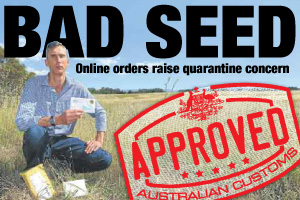The Invasive Species Council recently tested how easy it is to buy prohibited weeds online, and found quarantine seriously wanting.

Early in 2014 the Invasive Species Council was alerted to Ebay traders illegally offering Mexican feather grass (Nasella tenuissima) for sale. This grass has been described by weed experts as ‘a potential disaster for the Australian environment’.[1]
Modelling by the Queensland government shows that up to 170 million hectares could be at risk, in a wide band of woodlands and grasslands across Queensland, more than half of New South Wales and large areas of Victoria, South Australia and Western Australia.[2] Mexican feather grass is closely related to serrated tussock (N. trichotoma), which is causing severe damage to NSW’s native grasslands.[3]
Mexican feather grass is thought to be capable of invading an areas six times that of serrated tussock, and because it is unpalatable to stock and possibly native grazers is likely to be even more harmful.[4]
Our complaints to Ebay about one particular trader 100 seeds of Mexican feather grass for $1 were ignored. There was not even an acknowledgement of our complaint.
We also learnt that similar complaints over a number of months by the ACT Government were ignored. The ACT Government has reason to be very concerned. Not long after Bunnings and Big W were caught selling hundreds of Mexican feather grass plants in 2009 a national recall was issued and the companies were fined. Sometime later the ACT government found 10 Mexican feather grass plants growing on a Canberra property. The windblown seeds had piled over a metre high and half a metre thick against a house door and 10 cm of topsoil had to be removed as part of the eradication effort. Five years later, seedlings are still being removed during annual checks.
With some trepidation, we decided to put our quarantine system to the test.
Purchasing the seeds over Ebay was relatively quick and simple, and proceeded with no warnings about the potential risk of bringing prohibited seeds into Australia.
We also noticed for sale on Ebay another dangerous weed, Kochia scoparia. This shrub was eradicated from Western Australia in the 1990s . For this purchase there was a general warning that quarantine regualtions must be met but no information about whether this particular plant was legal. The Ebay information about prohibited items contained a broken link to the Australia Government quarantine conditions.
Within about a week the seeds arrived. We received 100 seeds of Mexican feather grass from SeedyFrenzy in New York, 100,000 seeds of Mexican feather grass from Leung Ka Man in Hong Kong and 100 seeds of Kochia scoparia from Chen Yang Bo in southern China.
Removing the letters from the letterbox, our CEO couldn’t help feeling how dangerous this was. He had to handle these time bombs with care.
Information on two of the three packages was explicit about their contents, the other was dishonest.
The Kochia scoparia customs declaration said: “Kochia scoparia 120 seeds. Gift: 120-plus seeds rare Kochia Scoparia grass seeds. Showy E~Z grow rapid exotic hardy.”
One of the Mexican feathergrass packages listed the contents as: “Gift: Plastic beads 1 pack”, and the other feathergrass was labelled as “Mexican feathergrass 100 seeds”.
Ebay is a behemoth with no obvious way to reach a person if there is a problem. While all items displayed a complaint link, it proved ineffective. The complaint link took us to a form asking the reason for the complaint. The only suitable category was ‘other wildlife items that can’t be listed’ and there was no place to explain the problem in detail
Illegal internet sales are recognised as a growing biosecurity threat. A paper presented by Heather Pearson and Richard Hill to the 2014 Australasian Weed Society conference said ‘The growing volume and speed of on-line trading of plant materials poses a significant threat to biosecurity worldwide.’
When we revealed to the biosecurity inquiry the ease of online purchases of prohibited seeds the jaws of the senators dropped.
In late November the NSW rural newspaper The Land ran a front-page story about our experience and officials started to take notice. In the last week we met government biosecurity compliance officers in Canberra who are keen to work with us to respond to illegal selling, and Ebay told The Land that they were also willing to work with us on the issue.
We need the federal agriculture department to determine the nature and extent of online illegal sales and to develop a compliance strategy. Internet trading platforms such as Ebay should prevent traders from selling prohibited species and improve their complaint mechanisms.
What you can do
The community can also play a valuable role by reporting suspected illegal sellers to biosecurity authorities and complaining to website trading site. To facilitate this work the Invasive Species Council has set up Border Patrol Eyes Online. Get involved if you are interested in helping to stop this serious threat.
Note: the purchased seeds have since been safely destroyed to ensure they no longer pose a risk and authorities have been notified.
[1] McLaren D, Stajsic V, Gardner M. 1998. The distribution and impact of south/north American stipoid grasses (poaceae: stipeae). Plant Protection Quarterly 13 (2): 62–70.
[2] Csurhes S. 2008. Mexican feather grass (Nassella tenuissima) – Pest plant risk assessment, Queensland Department of Primary Industries and Fisheries, Brisbane.
[3] McLaren D, Stajsic V, Gardner M. 1998. The distribution and impact of south/north American stipoid grasses (poaceae: stipeae). Plant Protection Quarterly 13 (2): 62–70.
[4] McLaren D, Stajsic V and Iaconis L. 2004. The distribution, impacts and identification of exotic stipoid grasses in Australia. Plant Protection Quarterly 19 (2): 59-66.


